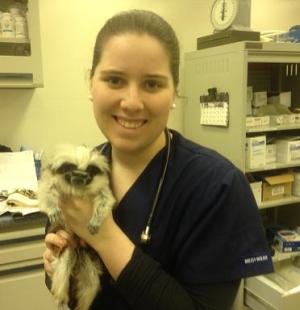Dangers at Both Ends
 Wednesday, June 26, 2013 at 12:00PM
Wednesday, June 26, 2013 at 12:00PM Winner, Foot in Mouth Category
Jenny Heath, Mississippi State University
 An unrelated, yet adorable, picture of our story's hero holding a cotton top tamarin monkey while on externship in Jackson, MS.It was a dark and stormy night in the equine corridors. The time…3 A.M.
An unrelated, yet adorable, picture of our story's hero holding a cotton top tamarin monkey while on externship in Jackson, MS.It was a dark and stormy night in the equine corridors. The time…3 A.M.
An exhausted vet student is trudging outside in the darkness. She is trying to reach the outer grounds of the complex, set on her mission. (Yes, this is already playing out like Jurassic Park in my mind. Just go with it.)
As she finally reaches the top of the hill, a long line of dim musty stalls greets her. It is very dark and deserted, the kind of quiet that you can only find in the dead of night, when even the owls have started to sleep. Thunder rumbles in the distance, and the animals themselves seem to sense the impending danger that looms on the horizon. They jitter and snort, stamping their hooves and tossing their manes in a nervous frustration.
The student walks cautiously, every nerve in her body suddenly hyperaware of her surroundings. She is alone, tired, and unexpectedly frightened here in the shadows. She fumbles for the light switch on a long metal post. It clicks up with a loud snap, and after a moment there is a fluttering and flickering of light above her. The bulbs are dim as they try to warm up, and she peers through the faint rays into the pitch black courtyard beside her. There is nothing but stillness. Occasionally a rusty gate creaks in the wind that is blowing in from the distant storm. The eeriness is astounding, and the student shakes herself a little, trying to rid the nervousness that has begun to seep into her bones much like her equine companions.
Have a painted a scary enough picture for you yet? Hmmm? Well get ready cause it’s about to get REAL.
 Mississippi State,
Mississippi State,  equine,
equine,  humor in
humor in  Foot in Mouth Disease
Foot in Mouth Disease 


